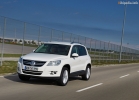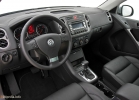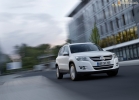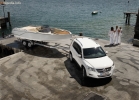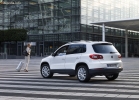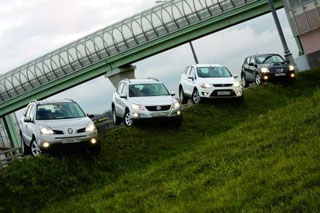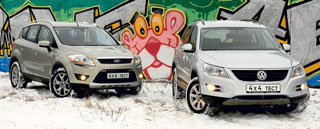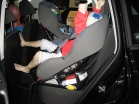Volkswagen Tiguan test drive since 2008 SUV
Volkswagen Tiguan test drive: for family interceter - comfortable and safe
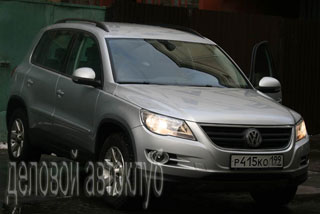 The first sensations in the movement are a very calm car. The speed is not felt either at 30km/h or at 120 km/h, the speed sensations occur only in 6 gear. By the way, the test drive took place both in the urban conditions of the capital's traffic jams and regional speeds, and along the highway Moscow Kursk Moscow, a total of 1260 km.
The first sensations in the movement are a very calm car. The speed is not felt either at 30km/h or at 120 km/h, the speed sensations occur only in 6 gear. By the way, the test drive took place both in the urban conditions of the capital's traffic jams and regional speeds, and along the highway Moscow Kursk Moscow, a total of 1260 km. The idea that after a few minutes I would sit behind the wheel of an SUV, caused conflicting emotions. Hmm, the dimensions will be more, you have to be more accurate ..,-spun in my head. And in front of me is the silver Volkswagen Tiguan, to the best of the large, but very accessible for my average height (170 cm). Without additional efforts, climbing the driver’s seat, I began to consider all the buttons, indicators and levers of the front panel.
Immediately striking the separation on the climate control functions for the driver and passenger. The temperature, direction and heating of the seat can be configured according to individual preferences. Four ventilation holes adjustable around their axis will be able to satisfy any, even the most picky user. True, the handle of a blowing power for everyone is one, so there are times disagreements can at times. In the extreme position of the regulator on the right, the fan is buzzing like a vacuum cleaner, but by the middle of the division it becomes almost soundless. By the way of the climate, Volkswagen Tiguan developers did not forget about passengers from behind and also installed 2 ventilation holes in the console.
Another of the first observations: empty steering wheel. Obviously, the Germans have their own opinion on this subject. And although the presence of climate control buttons and audio systems on the steering wheel allows you to not throw the steering wheel while moving, which naturally increases safety, in the execution of the Volkswagen Tiguan 1.4 TSI tested, these possibilities are absent. It seemed to me a mismatch in German pragmatics. But there are six airbags, a course stabilization system and a steering column that can be lifted or pushed by five centimeters for convenience and safety.
The windows buttons, as in many models, are located on the left and front on the driver's door panel. There is also a lever and switch of lateral mirrors. Honestly, it was not possible to configure the mirrors on the first attempt. Apparently because of the color of the hair, I could not think out that the Right-Levo switch is at the same time a Jostik, I inconsolably looked for a button. However, we will talk about the functions of mirrors when we move out.
The information panel standardly contains a tachometer, a speedometer, the arrow of the level of gasoline and the engine temperature, and the on -board computer. By the way, the latter turned out to be quite informative: a compass, a clock, a common and intermediate odometer, information about open doors, a key in the ignition lock and turned on is also accompanied by a sound signal. In addition, you can see the temperature overboard, current and average fuel consumption, average speed, etc. Additional indicators. The on -board computer control button is located at the end of the lever of the wipers and the washer of the glass to the right of the steering wheel. The headlight switch handle is on the left of the steering wheel on the panel and contains the functions of turning on the dimensions, near light, front and rear foglight heads. Next to it are 2 wheels-towers of the light of the information panel and headlight heights. The high light regulates the turning lever to the left of the steering wheel.
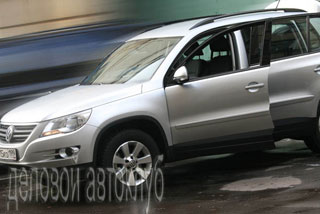 The standard car radio has an electronic scoreboard and a bunch of CD, TP, FM, AM, AS, menu, and aT-inspection buttons buttons. There are also 6 frequency and tracks buttons for faster switching. By the way, the car radio reads mp3.
The standard car radio has an electronic scoreboard and a bunch of CD, TP, FM, AM, AS, menu, and aT-inspection buttons buttons. There are also 6 frequency and tracks buttons for faster switching. By the way, the car radio reads mp3. Seats are a separate topic. There are several settings: the height, which is important for small and tall, tilt of the back of the seat (by the way, a separate regulator of the lumbar region can be considered a plus that allows you to repeat the bends of the spine as much as possible) and, of course, the distance to the panel. It is important to note here that the regulator's solar cloaks have a huge amount of divisions and superficial movement: raising the lever, I flew back with the sound of the crack and immediately rolled the seat to the desired level very accurately.
The distance to the front seats at the back is quite a lot, allows you to even stretch your legs. And on the back of the front, the developers added folding tables, as in an airplane. It is noteworthy that the rear seats also have a re-regulator lever, which makes it possible to push them by 16 cm and increase the already large space of the luggage compartment from 320 liters to 1510 liters. And if you add the front passenger chair, items up to 2.5 meters long will fit into the salon.
It is worth noting the option of parking brake. I did not find any lever button and only, and automatic when pressing the accelerator pedal, the handbrake is independently removed. However, if the driver is not fastened or the parking brake is not forced, the confident Tiguan will not move either forward or backward. There is another Auto Hold brake function, some confuse it with a handbrake, but the difference is significant. When it is activated, the car moves calmly, but in case of stopping on the way, for example, at a traffic light, the car does not roll back with a brake pedal released. Convenient in traffic.
Looking around in the cabin and, as they say, praying, moved. The first sensations in the movement are a very calm car. The speed is not felt either at 30km/h or at 120 km/h, the speed sensations occur only in 6 gear. By the way, the test drive took place both in the urban conditions of the capital's traffic jams and regional speeds, and along the highway Moscow Kursk Moscow, a total of 1260 km.
The weather in the literal sense was lucky, all the conditions found: dry asphalt, clean ice, rain, fog, blizzard, a stormy wind, but, about everything in order. The dimensions were not embarrassed for a minute, the overview of the cabin is magnificent. If you do not take into account, the greed of the German auto industry regarding the rear -view mirror is very small. True, side mirrors give a complete picture of what is happening around. Sitting in Tiguan, she remembered the phrase from the famous Russian folk tale: I sit high, I look far away. In a traffic jam on the 3rd ring of Moscow, life facilitated the Auto Hold function, and time could be spent on studying the variety of the front panel buttons.
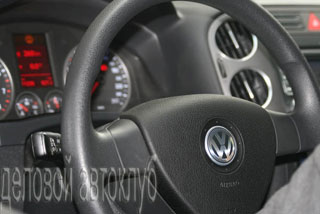 9 o’clock in the evening, traveling to the E-95 highway Sip of freedom and a slipper on the floor. However, while I hold 140 km/h, the flow of cars is quite dense, and there are a lot of traffic police posts. Immediately, it is worth noting the decent softness of the suspension all the pits and bumps I felt more than once on the personal hatchback Honda Civic 5d. The soft and strong Tiguan allowed to forget the bumps of the road and only sometimes calmly stepped over the springboard joints of the roadway.
9 o’clock in the evening, traveling to the E-95 highway Sip of freedom and a slipper on the floor. However, while I hold 140 km/h, the flow of cars is quite dense, and there are a lot of traffic police posts. Immediately, it is worth noting the decent softness of the suspension all the pits and bumps I felt more than once on the personal hatchback Honda Civic 5d. The soft and strong Tiguan allowed to forget the bumps of the road and only sometimes calmly stepped over the springboard joints of the roadway. The light of the headlights was bright, the feeling was created that there was xenon, however, with a careful examination, the lenses turned out to be, distant - shines to heaven. However, there is a minus: the headlights do not have janitors and washer. In the conditions of weather on the night route, I had to stop for wiping several times. But the windshield is slightly toned and the light of distant headlights from the oncoming movement does not blind at all.
Noise insulation, too, at the height of the sound of spikes or other extraneous sounds, is distracted from pleasure and tranquility. Even the growl of the motor at 6000 rpm does not create discomfort. It is appropriate to recall that the 1.4 TSI Turbo engine squeezes 148 horsepower, the maximum speed is up to 192 km/h. According to the manufacturer, Volkswagen was the first in the world to install an engine with direct injection and boost on a new SUV. This can significantly reduce fuel consumption and toxicity of waste gases, as well as improve the dynamics of the car.
At the expense of the fuel, it is true: in the mixed cycle I got the average OK. 9l/100 km. - This is taking into account 5 hours on Friday Moscow and a consumption that decreases to 4l on the highway. The Turbo mode is noticeably turned on on overtaking, fuel consumption reaches 46 liters, but the SUV confidently and without nerves costs a long truck string. It is a pity that weather conditions did not give the opportunity to press the accelerator pedal to maximum speed and cutting off at maximum speed.
The brakes also do not cause complaints: on the ice highway during emergency braking, stopped in a matter of seconds without drift, which indicates high -quality work of the course stability and anti -lock system. ABS really hits the leg significantly, but the result is more important. Yes, and ESP allows you to calmly pass smooth turns, almost without reducing speed. If we talk about stability, then even a squall side wind that played last Sunday in the Tula region could not bring down Tiguan from the course. Only the branches of trees, blinking and swinging 180 degrees of lanterns at gas stations spoke about the elements in the salon, were quiet and comfortable. A few words about manual transmission will also be positive. With a calm and clear movement, the lever finds the desired gear, as if in advance guessing the driver's thought.
In general, Volkswagen Tiguan is an excellent car for comprehensive use. And a lying policeman can be passed without reducing speed, and a family on a long journey go with confidence about security, and do not be nervous in the Moscow traffic jam. For the basic configurations of Tiguan with a 1.4 TSI engine, dealers ask for from 904 thousand rubles. In my opinion, it is quite affordable, and most importantly, there is something.
Author: Katerina Romanova
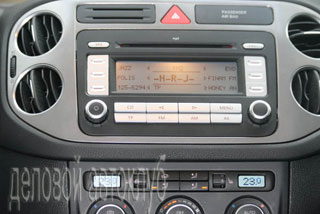
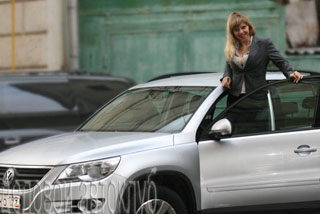
A source: Business car club
VOLKSWAGEN TIGUAN VIDEO VIDEO COMPANY since 2008
VOLKSWAGEN TIGUAN Crash Video since 2008
Volkswagen Tiguan test drives since 2008
Volkswagen Tiguan crash test since 2008
Krassh Test: Detailed Information34%
Driver and passengers
17%
Pedestrians
39%
Children-passengers

